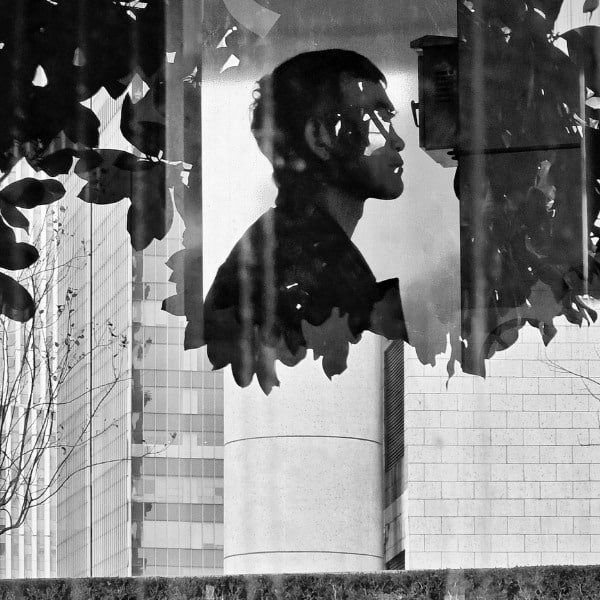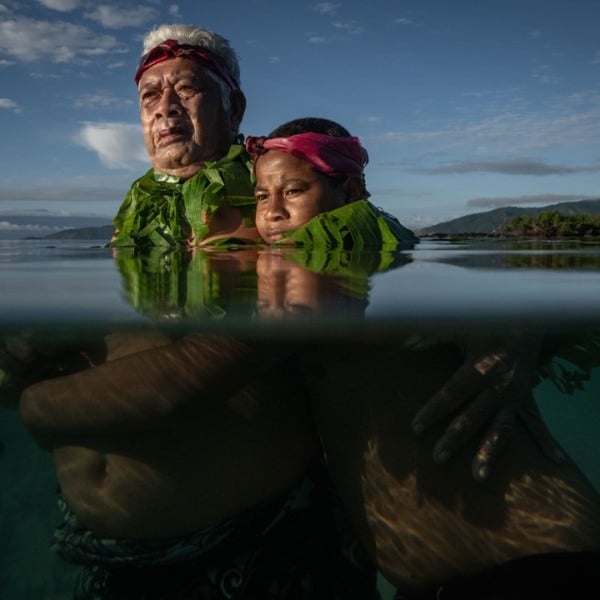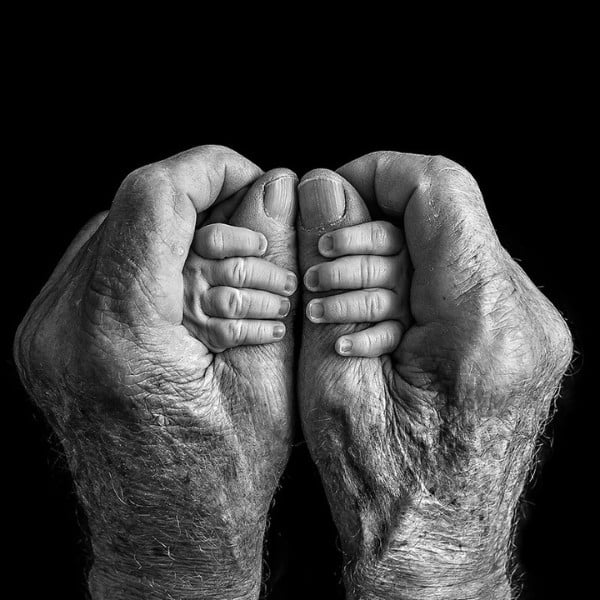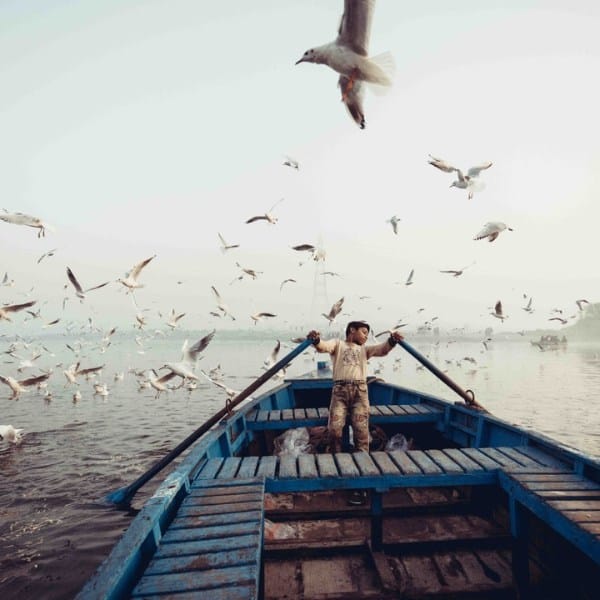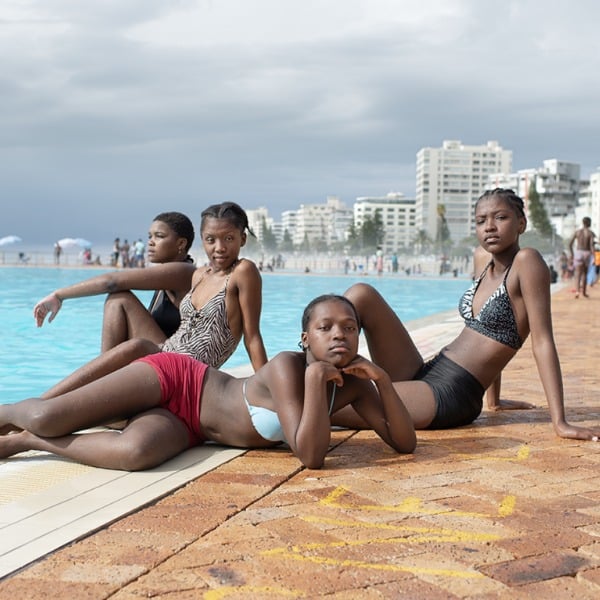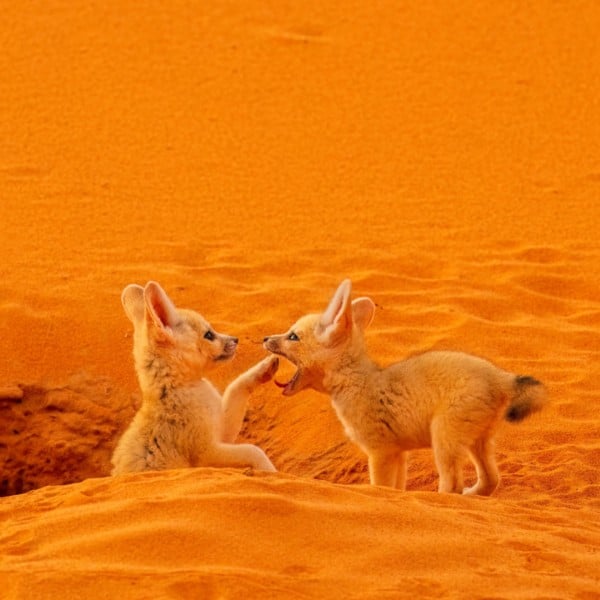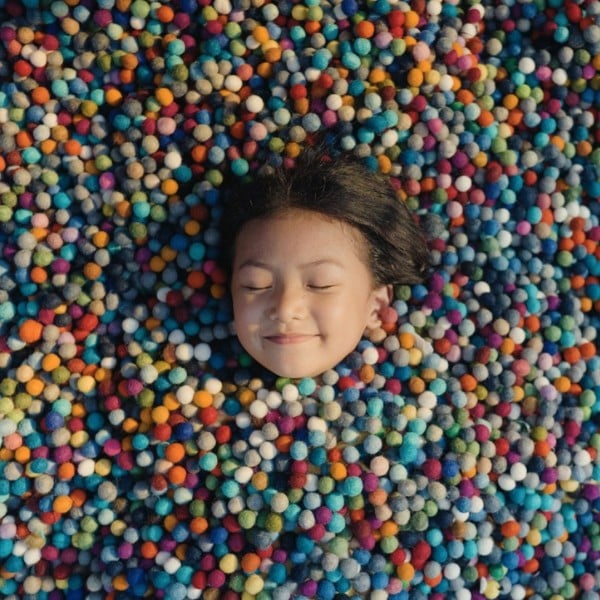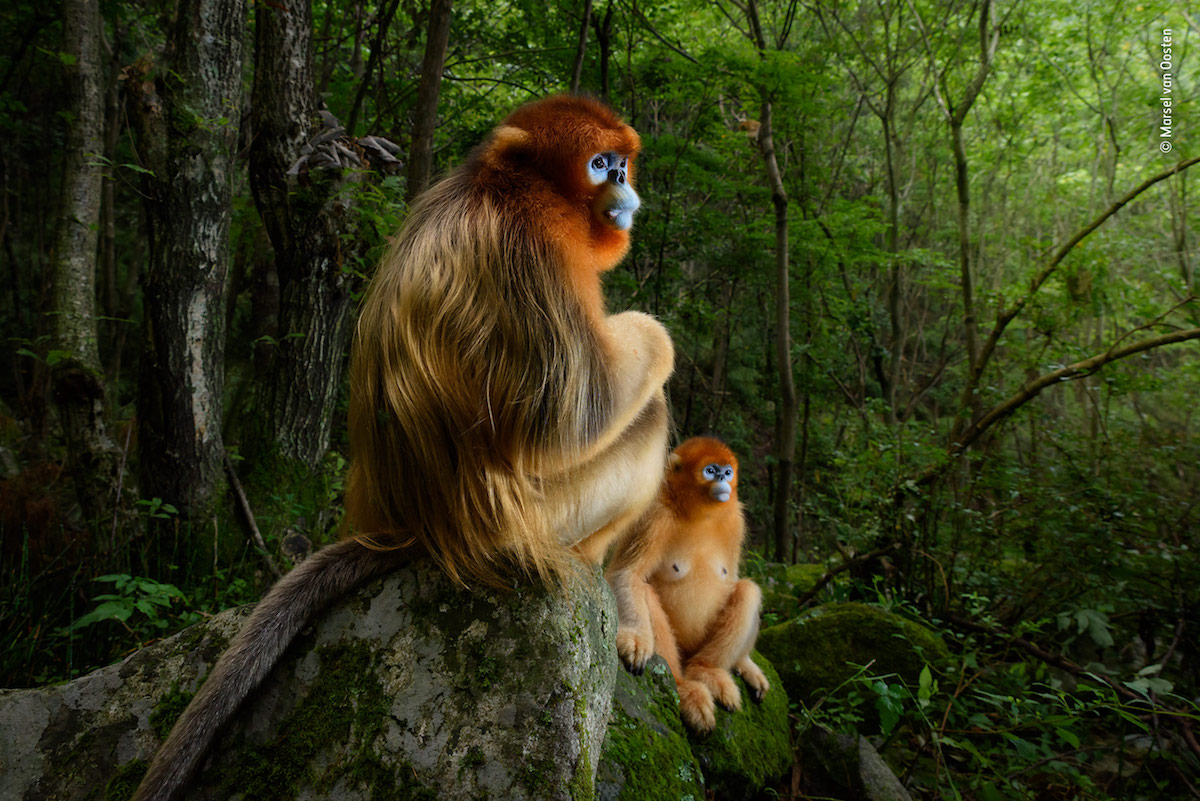
“The Golden Couple” by Marsel van Oosten (The Netherlands). 2018 Wildlife Photographer of the Year.
As the group of Qinling golden snub-nosed monkeys jumped from tree to tree, Marsel struggled to keep up, slipping and stumbling over logs. Gradually he learned to predict their behavior and captured this male and female resting. With the Sun filtering through the canopy, they are bathed in a magical light, their golden hair glowing against the fresh greens of the forest.
This pair belongs to a subspecies of golden snub-nosed monkey restricted to the Qinling Mountains. Among the most striking primates in the world, these monkeys are in danger of disappearing. Their numbers have steadily declined over the decades and there are now fewer than 4,000 individuals left.
The winners of the prestigious Wildlife Photographer of the Year competition have been announced, with Dutch photographer Marsel van Oosten taking the top prize for his beautiful portrait of a pair of endangered golden snub-nosed monkeys. In the youth category, 16-year-old Skye Meaker was named Youth Wildlife Photographer of the Year for his moving portrait of a leopard waking from sleep in a game reserve in Botswana.
Van Oosten and Meaker were selected from 19 category winners, all of whom impressed the judges with their abilities to share their perspectives on wildlife. This year's competition saw over 45,000 submissions from 95 countries, which were judged by an expert panel on their originality, creativity, and technical excellence.
The winning image Golden Couple, taken in China’s Qinling Mountains, is a moving look at these animals and the fragility of nature. “This image is in one sense traditional—a portrait. But what a striking one, and what magical animals,” said Roz Kidman Cox, chair of the judging panel. “It is a symbolic reminder of the beauty of nature and how impoverished we are becoming as nature is diminished. It is an artwork worthy of hanging in any gallery in the world.”
From glimpses of life underwater to heartbreaking images of exploited animals, the winning entries demonstrate both the beauty of wildlife and the perils they currently face. The competition, which is organized by the Natural History Museum, awards single images, as well as portfolio work and long-form photojournalism. This year, Mexican photographer Alejandro Prieto won the Wildlife Photojournalism: Story category for his examination of the plight of jaguars in Mexico and their struggle to survive.
New to the 2018 competition is the Lifetime Achievement Award. Esteemed wildlife photographer Frans Lanting was honored with the inaugural prize for his “outstanding contribution to wildlife conservation over more than three decades.”
The winning photographs, along with highly commended images from this year's contest, will be on display at the Natural History Museum through summer 2019 before touring across the UK and internationally. Thinking about submitting your work for next year's contest? The 2019 Wildlife Photographer of the Year will be accepting entries from October 22, 2018 to December 13, 2018.
The Wildlife Photographer of the Year contest announced their winners, including the top entries for the youth competition.

“Lounging Leopard” by Skye Meaker (South Africa). 2018 Youth Wildlife Photographer of the Year.
Notoriously shy and elusive, the resident leopards of the Mashatu Game Reserve are hard to spot. But this time Skye was in luck. After tracking the leopards for a few hours, he came across Mathoja – a well-known female. In a fleeting moment, just before the leopard nodded off, Skye captured a peaceful portrait of this majestic creature.
Named by local guides, Mathoja means ‘the one that walks with a limp’ – a title given to her after a serious leg injury as a cub. Although her chances of survival were slim, Mathoja is now a healthy adult. She is one of the lucky ones – this species has been classed as vulnerable and many leopards are illegally hunted for their highly desirable skins.
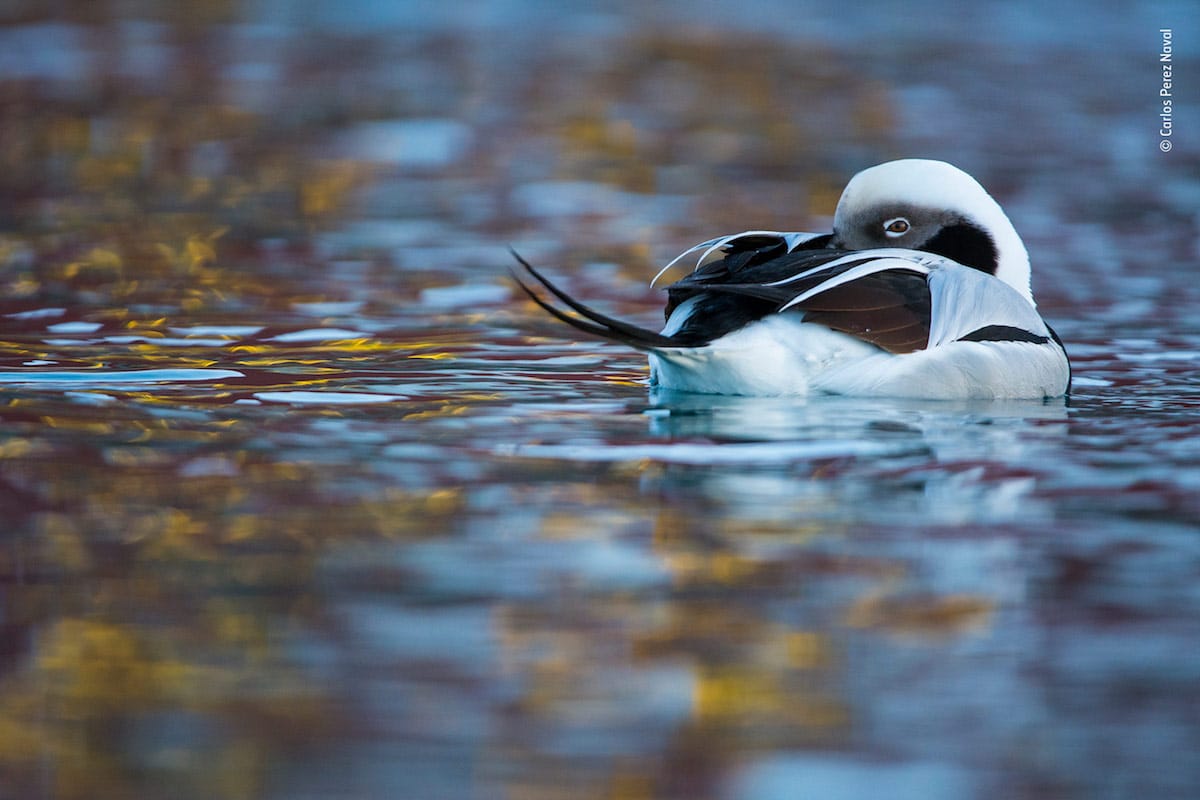
“Duck of Dreams” by Carlos Perez Naval (Spain). Winner, 11–14 Years Old.
Early one morning during his Easter holiday, Carlos slipped off the side of the boat and settled himself into a floating hide – it was the perfect spot to observe Arctic bird species. As morning broke, dozens of long-tailed ducks emerged, and as the light reflected off the water, Carlos captured this portrait of one dozing.
The Barents Sea supports one of the largest concentrations of seabirds in the world, including the long-tailed duck. This male still has its winter plumage – a less vibrant version of its summer colors. It is thought that its mainly white appearance might help to reduce aggression between males, who tend to live together in large flocks during the winter.
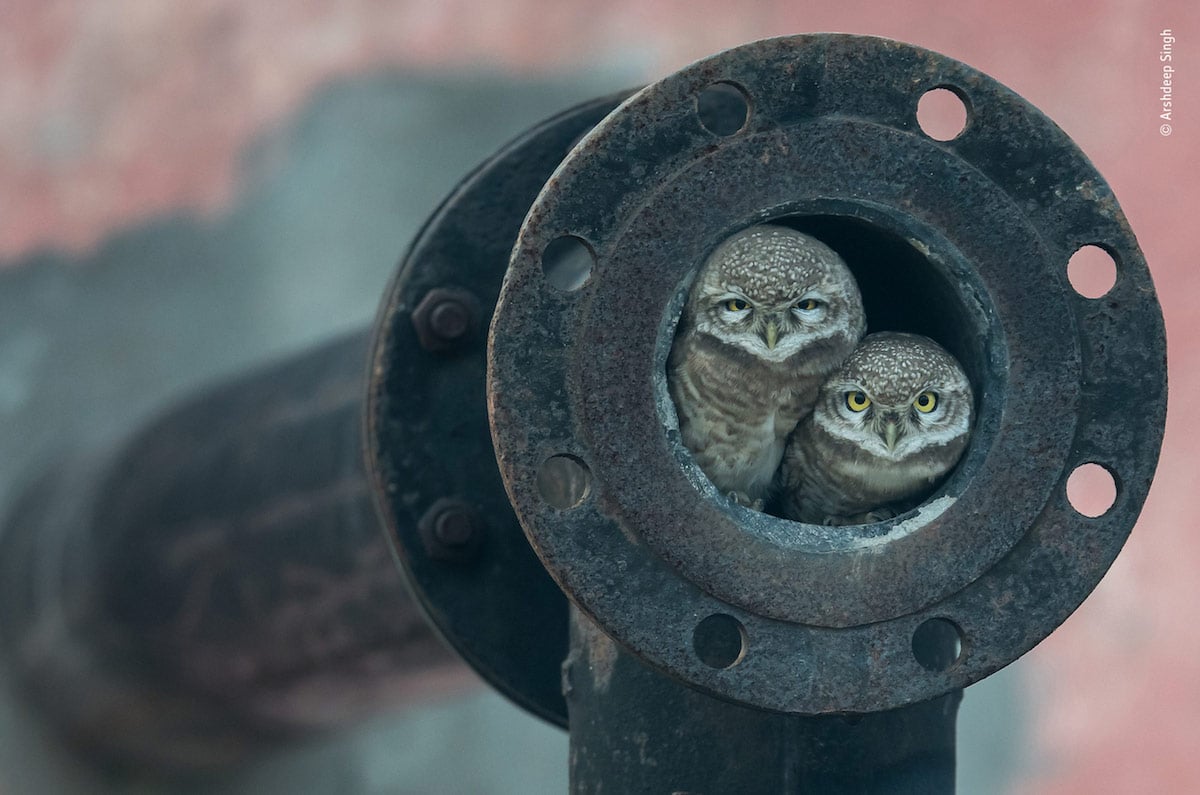
“Pipe Owls” by Arshdeep Singh (India). Winner, 10 Years and Under.
While driving with his father through the city, Arshdeep saw a bird disappearing into an old waste-pipe. He asked to stop the car, then primed his father’s camera and telephoto lens, kneeling up on the seat and resting it on the half-open window at eye-level. It wasn’t long before a spotted owlet emerged, followed by a second. Both stared right at him.
Spotted owlets traditionally nest in tree hollows, where the female lays up to five eggs. Although common in the Punjab, these small birds are rarely seen in the day, as they are nocturnal. This breeding pair – the larger female on the left – is among those using urban nesting sites following widespread deforestation in the region.
The winning photos highlight both the beauty and peril of the natural world.
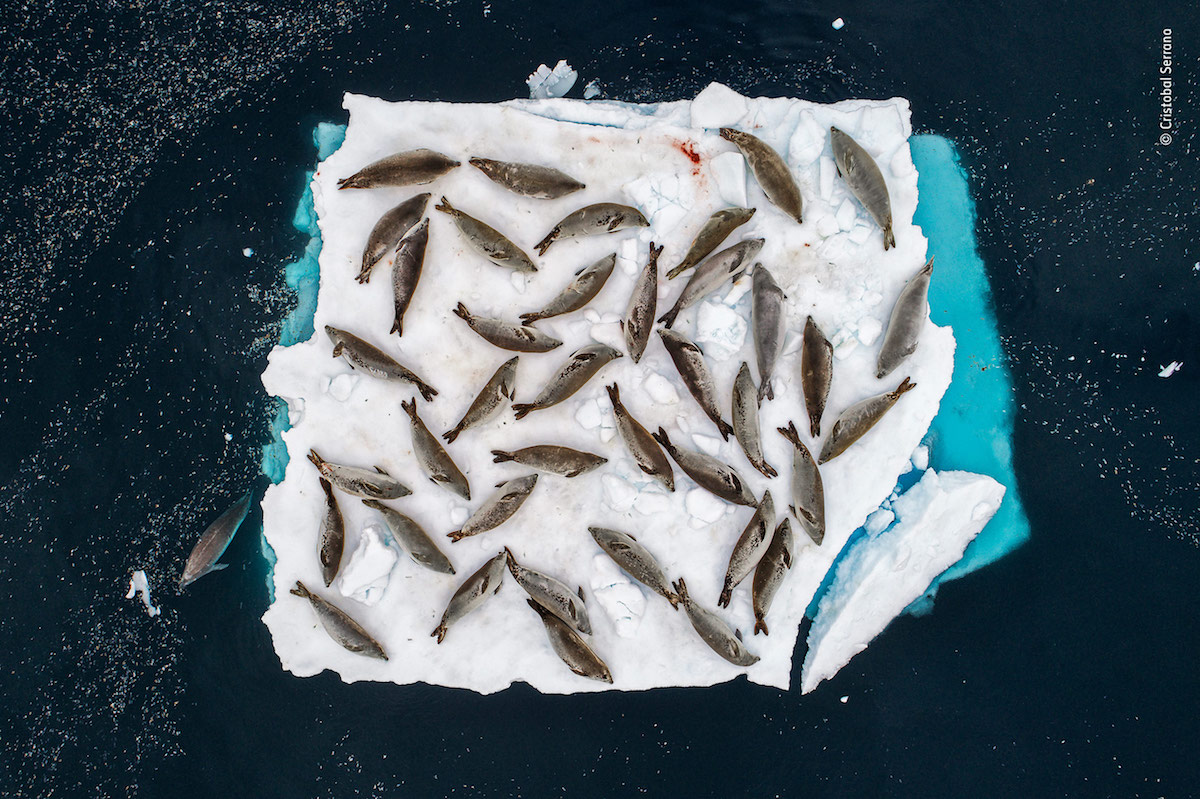
“Bed of Seals” by Cristobal Serrano (Spain). Winner, Animals in Their Environment.
The sea was relatively calm when Cristobal launched his drone from a small rubber dinghy in the Errera Channel of the Antarctic Peninsula. Rising above the sea, the drone revealed a small ice floe spilling over with crabeater seals. Part of the ice was splattered red with their excrement – the digested remains of their favorite food, krill.
Crabeater seals are gregarious, and if space allows they will cluster on ice floes in their hundreds. The seals are dependent on the ice – they rest and breed on top of it, but also feed on the krill that shelter underneath. As a result, a decline in sea ice not only strips these seals of places to haul themselves out of the water but also threatens the availability of their food supply.
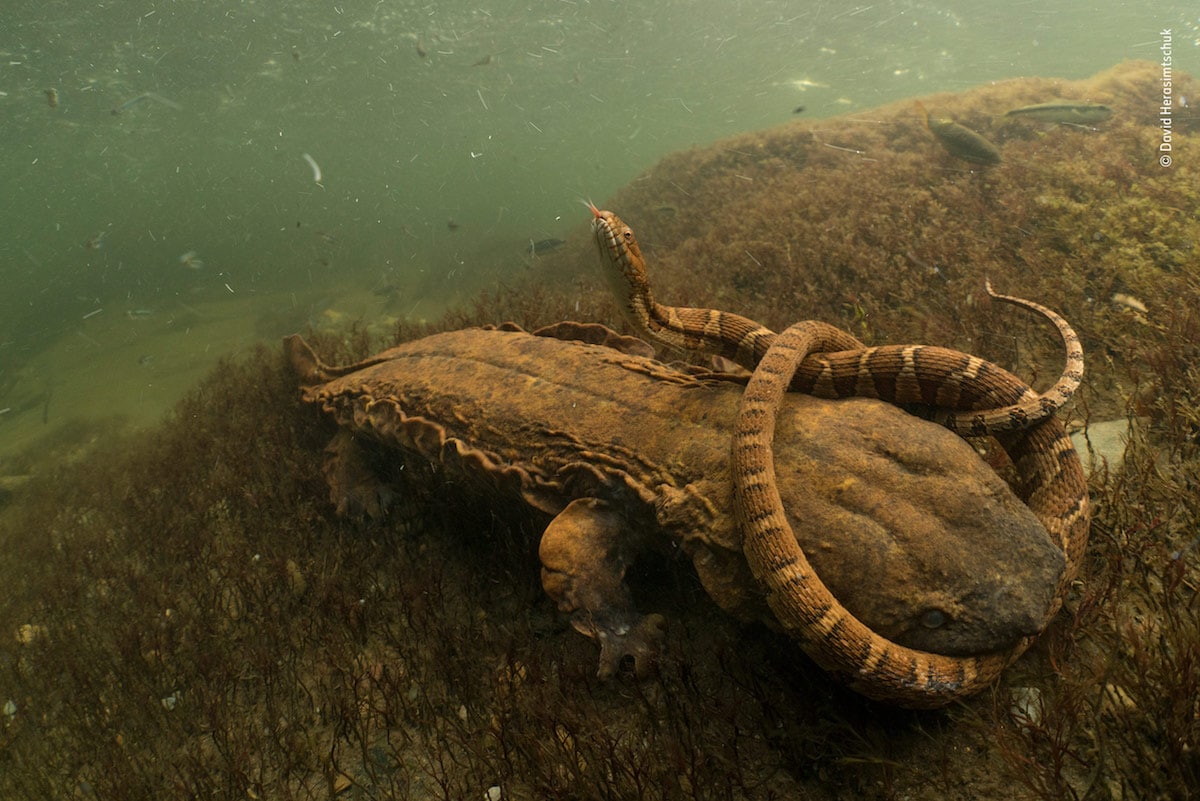
“Hellbent” by David Herasimtschuk (USA). Winner, Behaviors Amphibians and Reptiles.
Clamped in the jaws of a hungry hellbender salamander, things were not looking good for the northern water snake. But when its attacker repositioned its bite, the snake pushed free and escaped. David was thrilled to catch a battle between these two unlikely foes. ‘I’ve seen hellbenders display an array of behaviors, but this was by far the most remarkable,’ he says.
Hellbenders are the largest salamanders in the USA and are among the most endangered. Usually, they hunt for small prey, such as crayfish, insects, and eggs, so a northern water snake is an unexpected choice. These amphibians use suction to secure their prey before using their teeth – a method unlikely to subdue a wriggling snake.
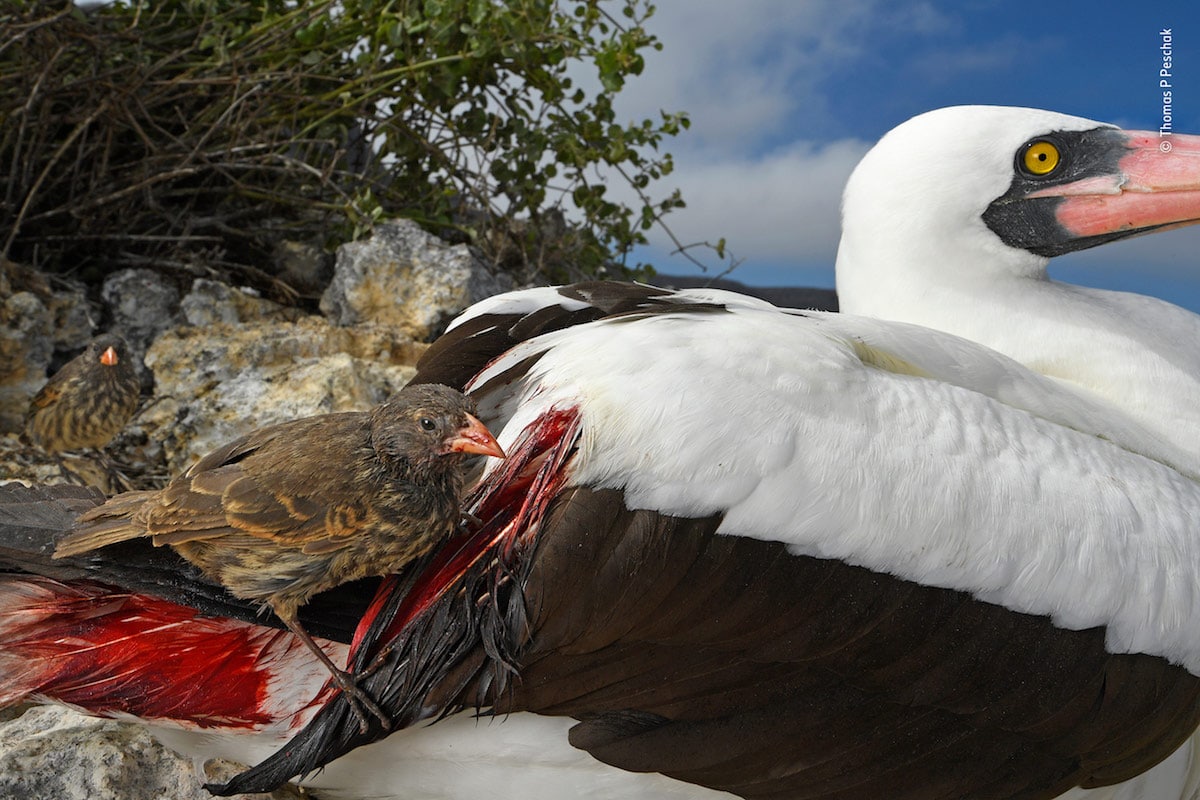
“Blood Thirsty” by Thomas P. Peschak (Germany / South Africa). Winner, Behaviors Birds.
Working on a climate change story, Thomas had secured a rare permit to land on Wolf Island, a remote part of the Galápagos Islands. Scrambling over loose rocks to reach this plateau, he spied a bizarre scene – pecking away at the flight feathers of a Nazca booby was a sharp-beaked ground finch. With scarce food alternatives, it had resorted to drinking blood to survive.
Encircled by steep cliffs, with no permanent water and little rainfall, Wolf Island is a difficult place to live. While the boobies can fish in the ocean, the finches are limited to a scant supply of seeds and insects. To survive they drink the blood of the Nazca boobies – a behavior that may have evolved from feeding on parasites in their feathers.
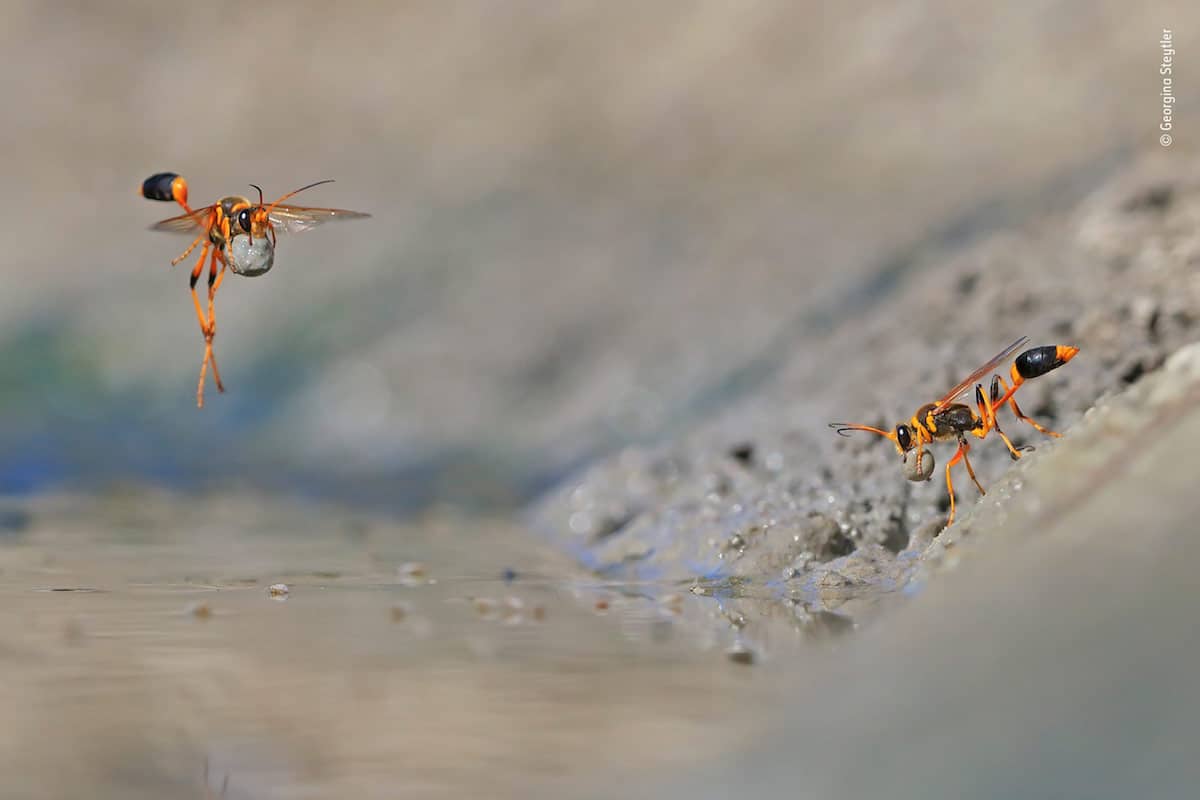
“Mud-Rolling Mud-Dauber” by Georgina Steytler (Australia). Winner, Behaviors Invertebrates.
Georgina was at the waterhole early to photograph birds, but her attention was diverted to these industrious wasps. They were busy at the water’s edge, rolling the soft mud into balls and carrying them to their nearby nests. For a good angle, she lay in the mud, then pre-focused on a likely flight path and began shooting continuously.
The female mud-dauber wasps use the mud balls to build their nests. Collecting them into clusters, they then carve chambers inside the balls into which the females lay their eggs. Before closing each one up, the wasps insert the paralyzed bodies of orb-weaving spiders as food for their larvae when they hatch.
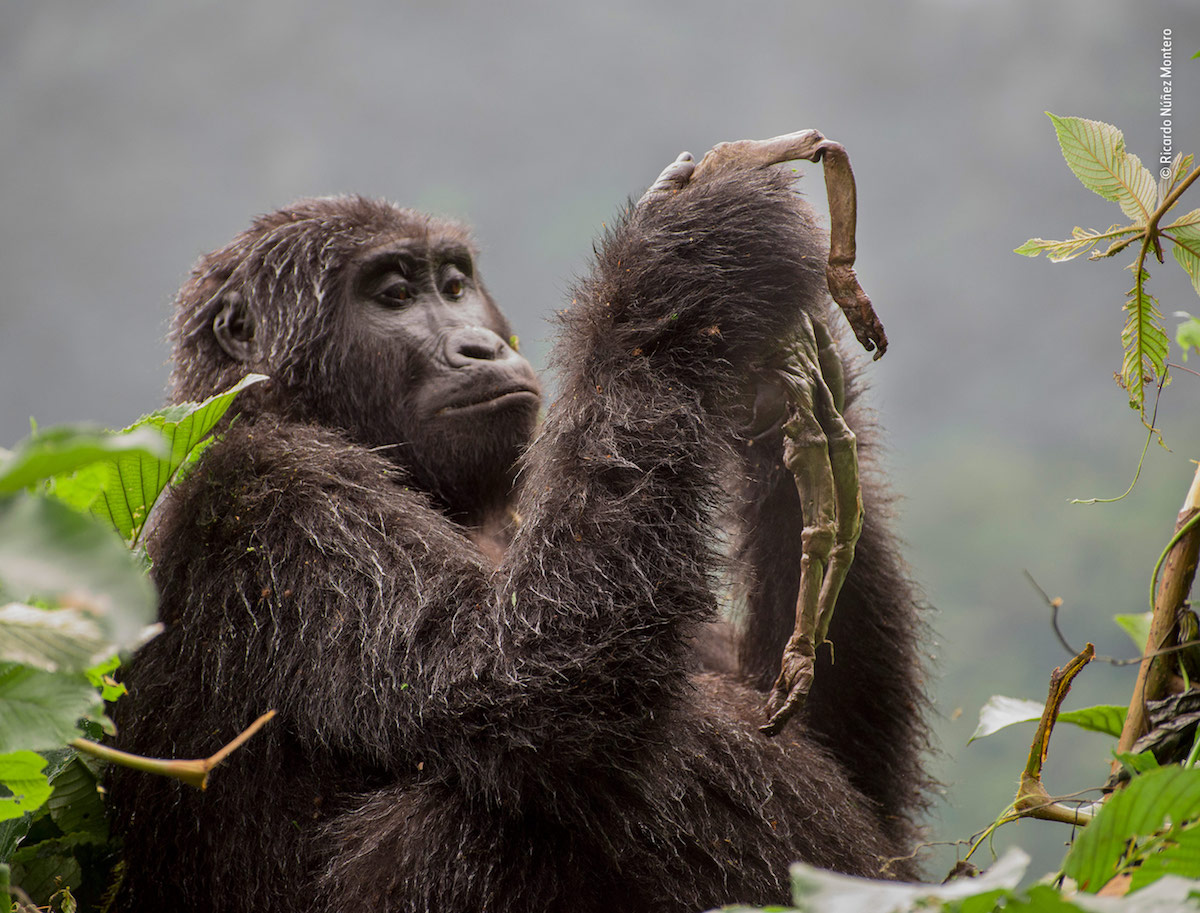
“Kuhirwa Mourns Her Baby” by Ricardo Núñez Montero (Spain). Winner, Behaviors Mammals.
Kuhirwa, a young female mountain gorilla, would not give up on her dead baby. Initially, she cuddled and groomed the tiny corpse, carrying it piggyback like the other mothers. Weeks later, she started to eat what was left of it. Forced by the low light to work with a wide aperture and a narrow depth of field, Ricardo focused on the body rather than Kuhirwa’s face.
From elephants stroking the bones of deceased family members to dolphins trying to keep dead companions afloat, there is an abundance of credible evidence to show that animals visibly express grief. Kuhirwa’s initial actions can be interpreted as mourning, her behavior showing the pain of a mother who has lost her child.
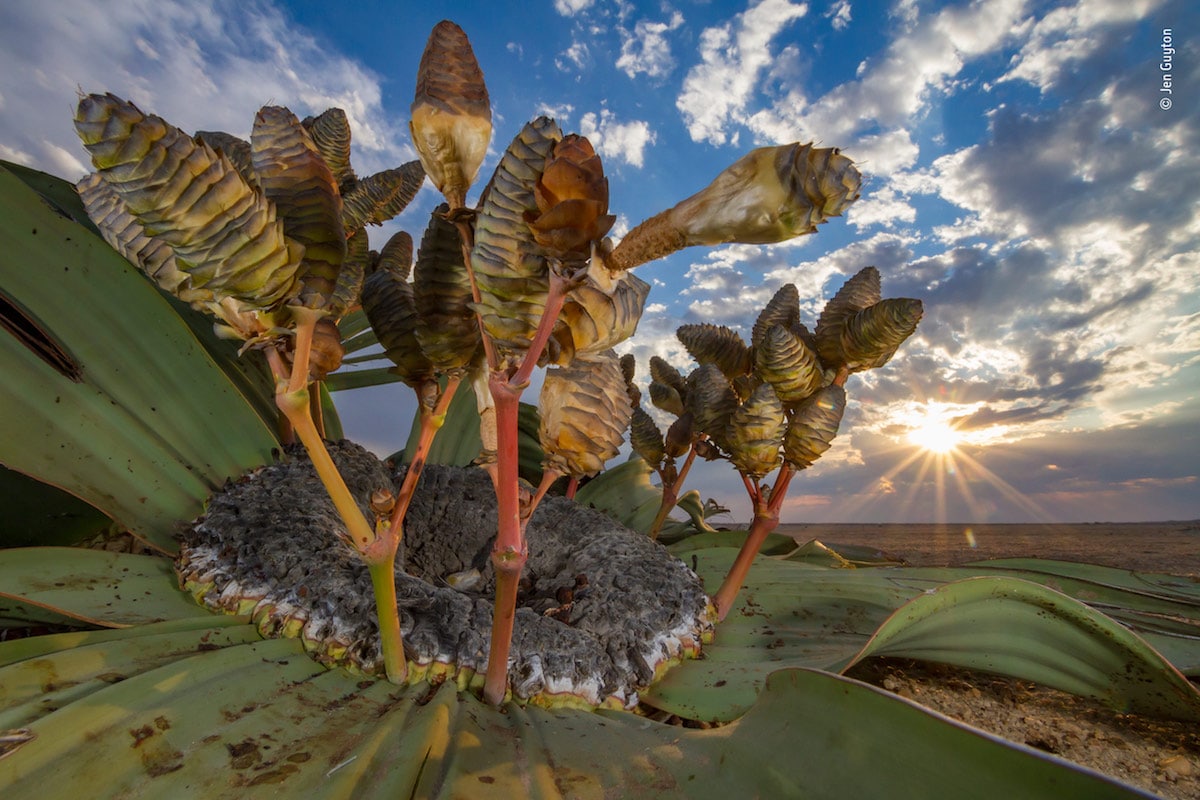
“Desert Relic” by Jen Guyton (Germany / USA). Winner, Plants and Fungi.
Jen had trekked all day across the Namib Desert looking for the perfect welwitschia plant to photograph before finally spotting this ragged-leaved subject. Adopting a low, wide angle, she caught the plant’s architecture and vibrant tones against the expansive landscape, just as the Sun was going down. ‘It’s like something out of a Dr. Seuss book,’ she says.
The weird and wonderful welwitschia plant can live for up to 1,000 years. Growing from the base, it is comprised of just two slow-growing leaves that creep over the desert throughout the lifetime of the plant. As the centuries take their toll, the leaf ends fray and split taking on the appearance of multiple leaves.
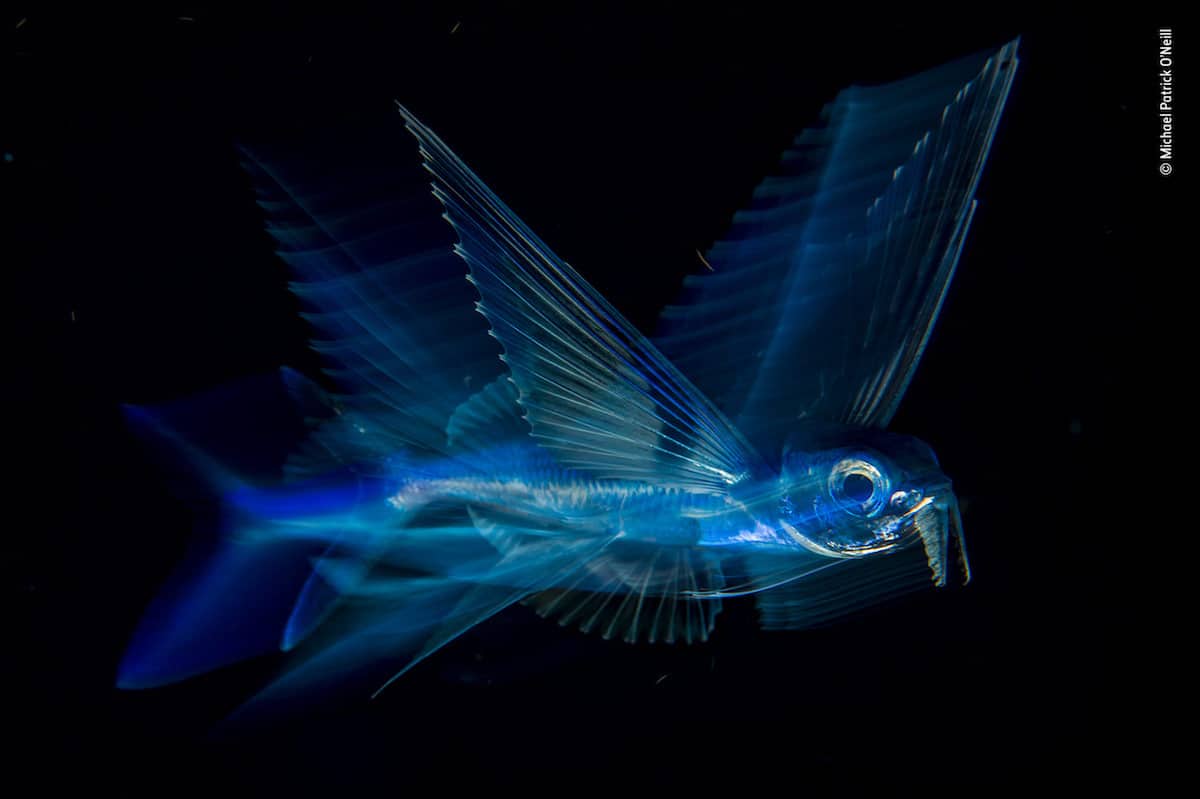
“Night Flight” by Michael Patrick O’Neill (USA). Winner, Underwater.
Late one night, over deep water, Michael was following a flying fish. By day, they move extraordinarily fast, but at night they swim slowly just below the surface. He tried various shutter and flash settings, all the while keeping track of his small subject. ‘I wanted to create a sense of movement,’ he says.
By rapidly beating their forked tails, flying fish such as this juvenile propel themselves in the water until they take off at the surface. By holding their long, pointed pectoral fins out stiffly, they can glide in the air for several hundred meters, away from underwater predators.
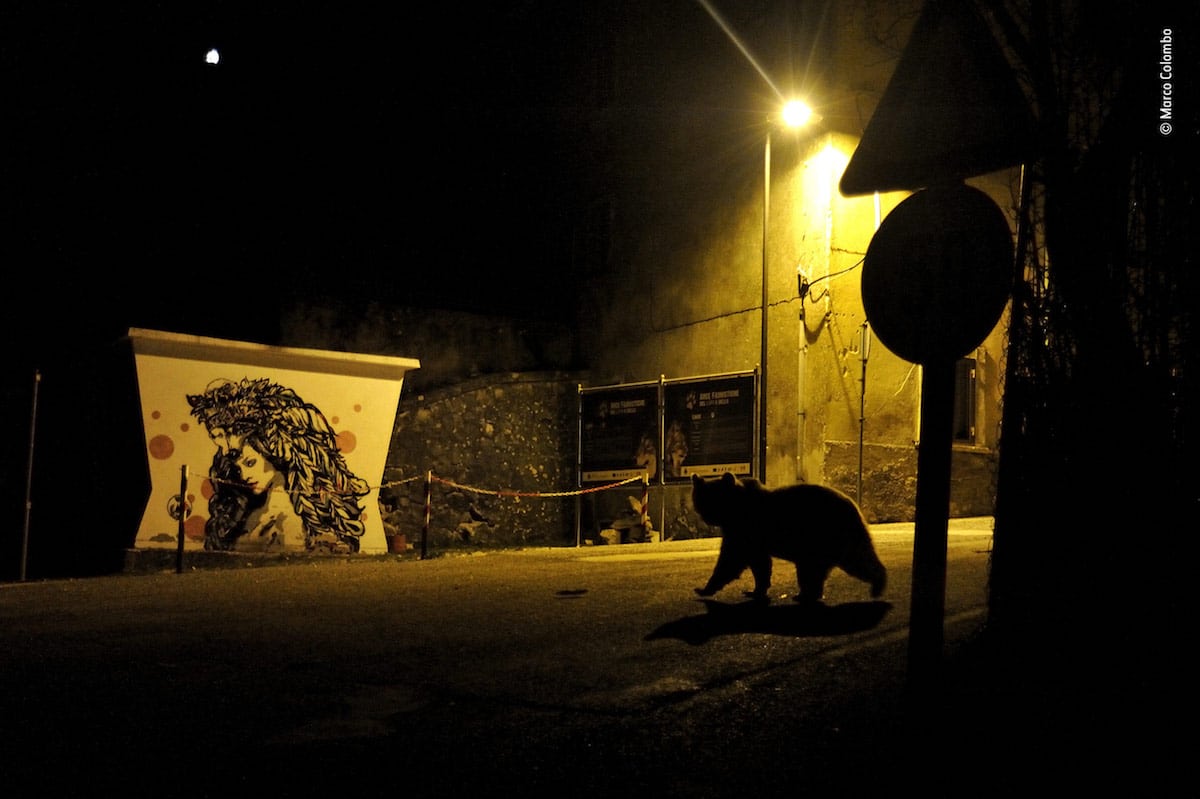
“Crossing Paths” by Marco Colombo (Italy). Winner, Urban Wildlife.
As Marco drove through the village late one evening he spotted a rare Marsican brown bear in the road. Immediately, he switched off his engine and lights so as not to disturb it, and watched as the bear strode across the street. With just seconds to spare he managed to photograph the female through the windscreen before it slipped into the shadows.
Marsican bears are an isolated and critically endangered sub-species of brown bear. With their habitat fragmented and threatened, they often come into contact with humans as they raid vegetable gardens and orchards to prepare for winter hibernation. Sadly on rare occasions, humans poison them in retaliation.
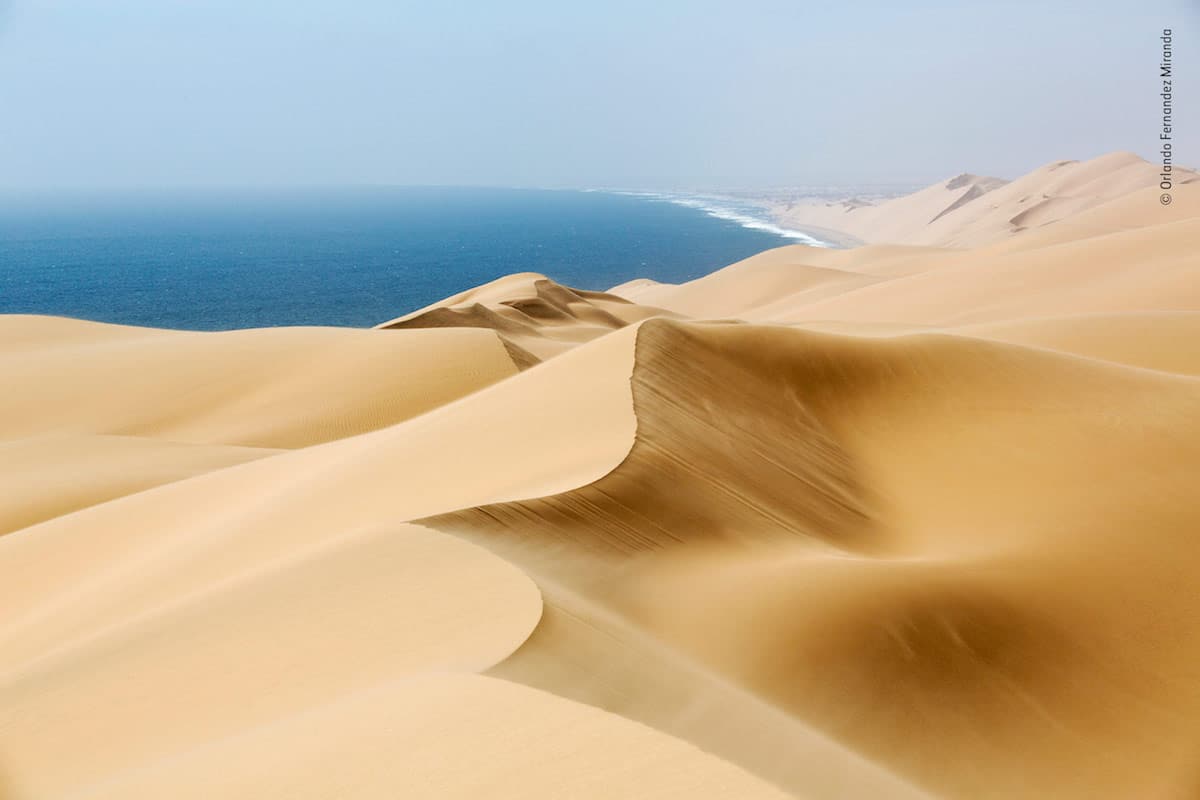
“Windsweep” by Orlando Fernandez Miranda (Spain). Winner, Earth’s Environments.
At the top of the dune, Orlando faced a trio of weather elements: a fierce northeasterly wind, warm afternoon sunshine and a dense ocean fog. Using the sharp ridge of sand in front of him as a focal point, he kept the sweep of dunes to his right in focus, leaving the distant coastal landscape, hidden behind a curtain of fog, a mystery.
A mix of fog and sunshine is not unusual on the Skeleton Coast. Cool winds from the Benguela Current – an ocean current that flows northwards – mix with the arid climate of the Namib Desert to create thick fog. The moisture from this fog spills inland and is vital to the survival of many plants and insects.
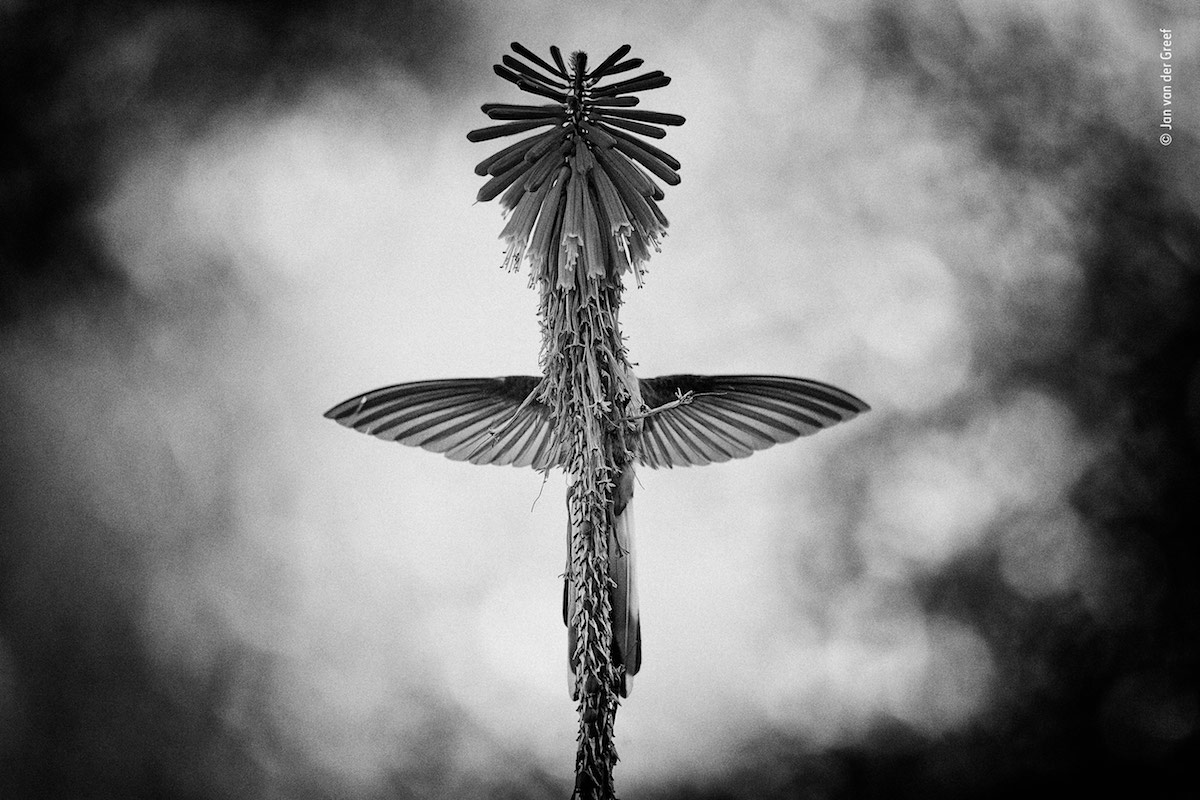
“The Vision” Jan van der Greef (The Netherlands). Winner, Black and White.
From the garden of his hotel, Jan noticed that when the hummingbirds rotated around this plant’s spikes, and closed their tails for a moment, a beautiful cross appeared. From the low position of his wheelchair, it took him two half days to get the perfect shot, ‘their fast movements to me symbolize the freedom of our imagination,’ he says.
Endemic to Peru, the bearded mountaineer hummingbird spends its day feeding on sweet, nectar-rich plants. Unlike the hummingbird, the showy, dramatic torch lily seen here is not native to the region, but has become a popular food source for these hummingbirds. They are attracted by the delicious nectar of its bright red flowers.
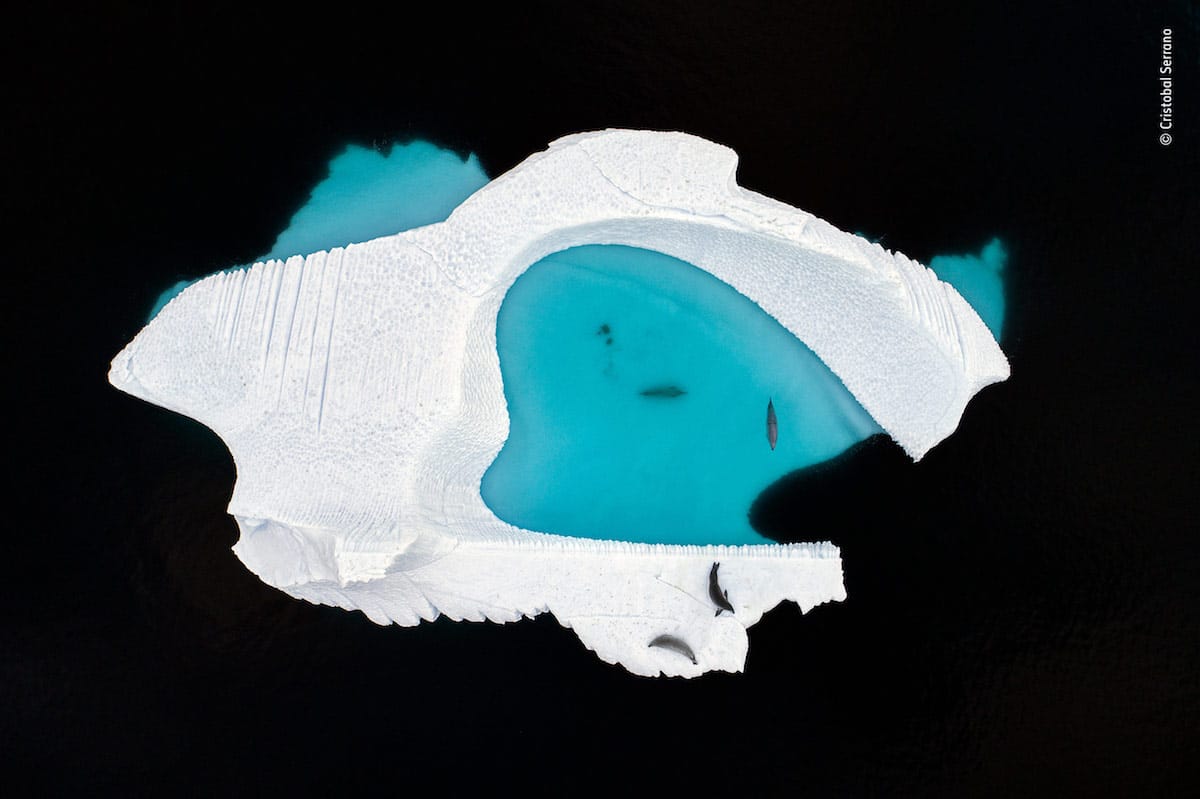
“The Ice Pool” by Cristobal Serrano (Spain). Winner, Creative Visions.
“Humans have tried to master the art of sculpture, but icebergs show us we are no match for nature’s great design,” explains Cristobal. To reveal the beauty of this spectacular ice carving, he used a low-noise drone, flying it high so as not to disturb the crabeater seals. The aerial viewpoint showed a heart-shaped pool in the iceberg’s center.
Crabeater seals feed primarily from dusk to dawn, hauling out onto the ice around the middle of the day to rest. The clear blue area in this image is where the iceberg has melted away below the waterline, creating a small and shallow pool, contrasted against the deep and dark ocean.
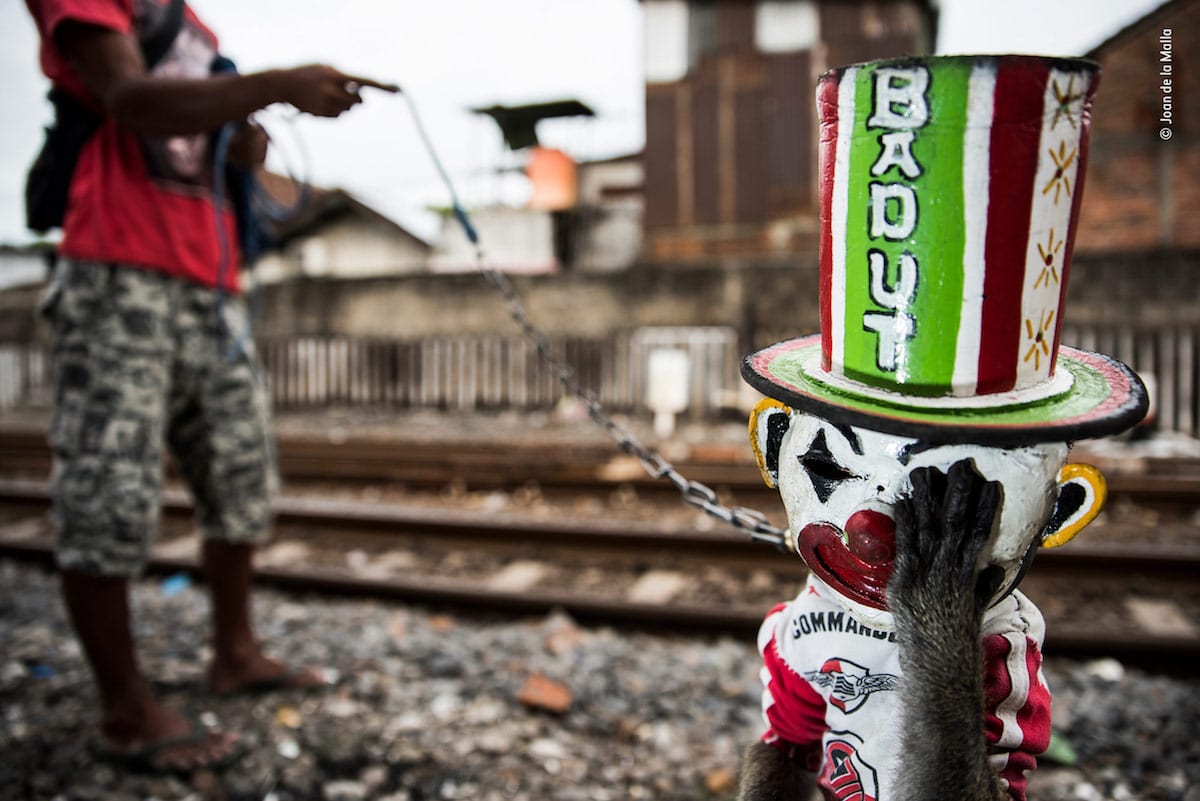
“The Sad Clown” by Joan de la Malla (Spain). Winner, Wildlife Photojournalism, Single Image.
Timbul, a long-tailed macaque, puts his hand to his face to try and relieve the discomfort of his mask while being trained to stand upright for a street show. Sights such as this are common in Indonesia, and Joan spent a long time gaining the trust of the monkey’s owners. ‘They are not bad people,’ she says. Most are earning money to send their children to school.
Macaques like Timbul live in awful conditions, deprived of the social relationships they need to thrive. They work many hours, dancing and riding bikes, movements that are unnatural and uncomfortable. Animal charities are working to enforce legislation that makes it illegal to take young monkeys from the wild or to trade in them without a permit.
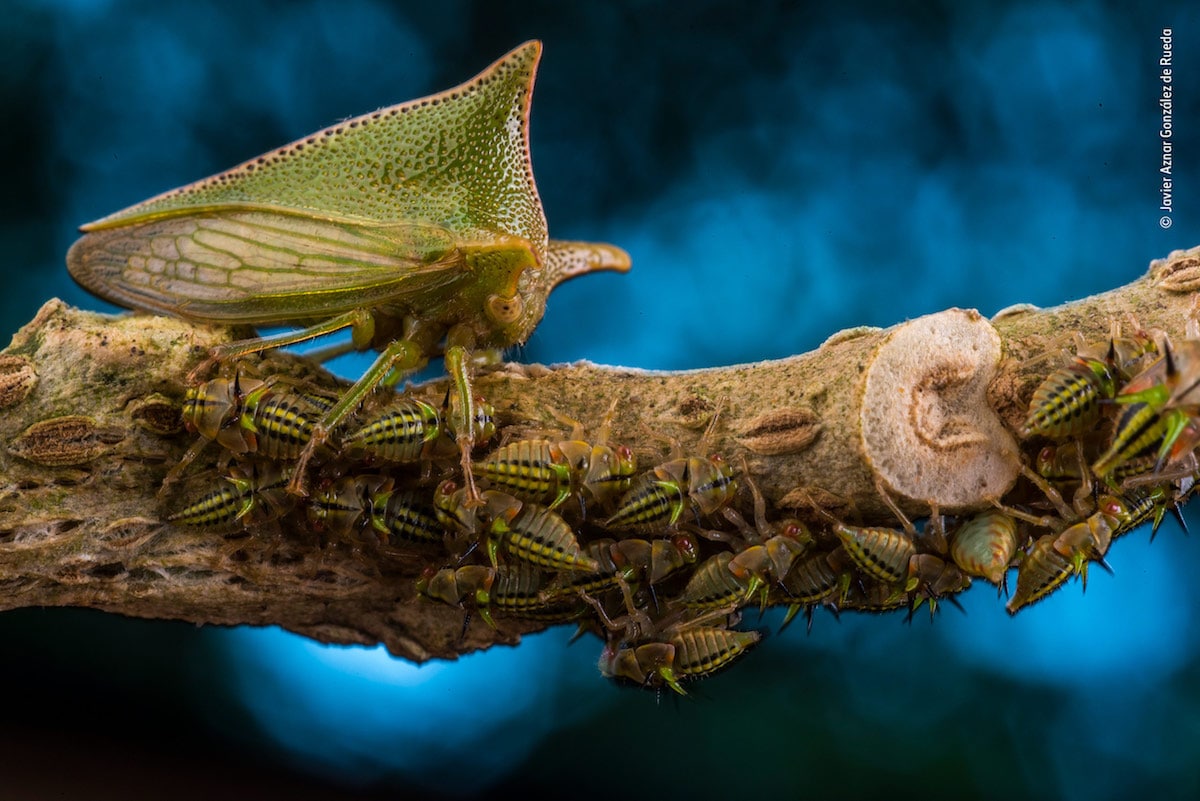
“Mother Defender” by Javier Aznar González de Rueda (Spain). Winner, Wildlife Photographer Portfolio Award.
Javier found this treehopper by the kitchen of the forest lodge he was staying in. He tried for several days to capture the scene, but the constant rain was a challenge. Eventually, he succeeded in creating this touching portrait of a mother guarding her young on the underside of a stem, enhanced by the blue glow of the sky behind.
The spiny projection on the treehopper’s back is called a helmet and is used to deter predators. This tiny female, around one centimeter long, will twist her body to wield her spine at any attackers. Once her eggs hatch, they develop through five nymphal stages, before becoming adults, and the devoted mother watches over them throughout.
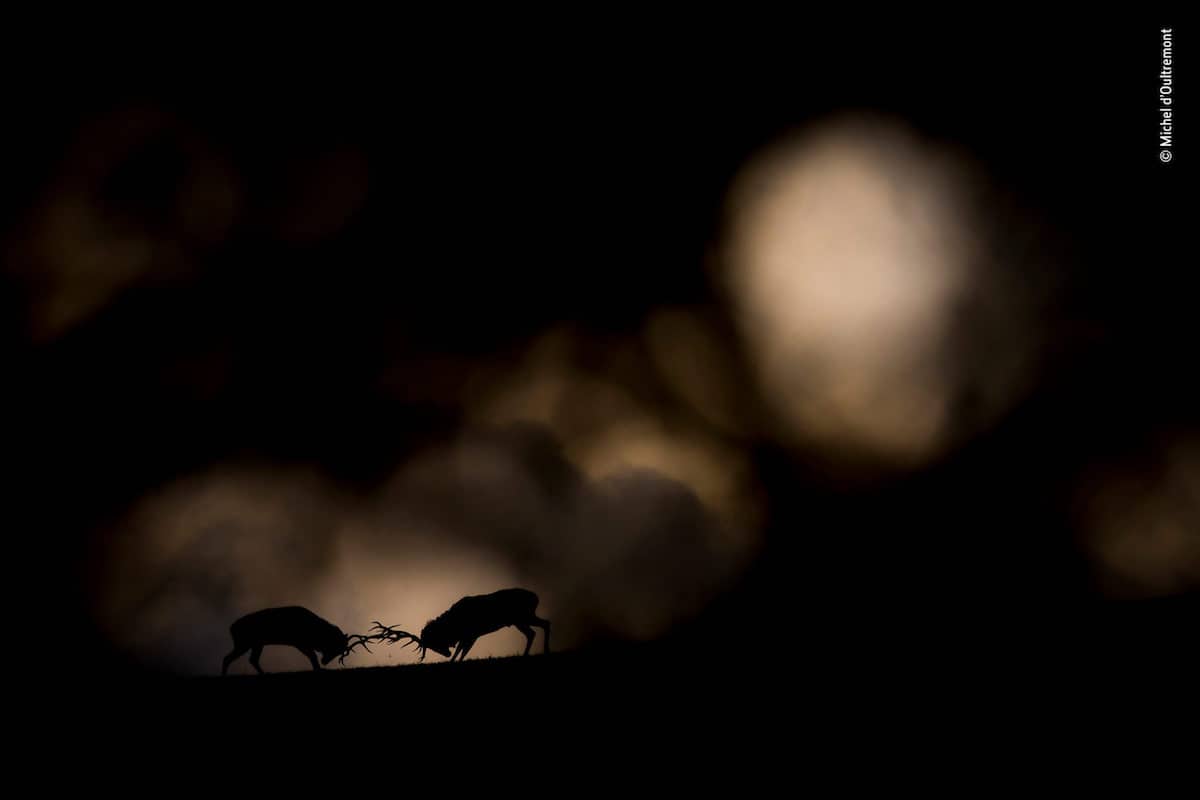
“Dream Duel” by Michel d’Oultremont (Belgium). Winner, Rising Star Portfolio Award.
As storm clouds gathered over the forest, the roaring sound of two competing red deer stags echoed through the trees. Well matched, neither challenger would walk away, so the contest escalated to a dramatic clash of antlers. Michel, hiding behind a tree under a camouflage net, had time to capture just a few frames before the stags separated.
Every autumn, young males, known as bucks, begin the annual search for a mate and compete to attract female attention. In preparation, males will often binge on fallen conkers, bulking up for their displays of strength. During the rutting season, bucks will stand side by side, assessing their rivals before locking antlers and going into battle.
Alejandro Prieto's series about the plight of jaguars in Mexico won the top prize in the long-form photojournalism category.
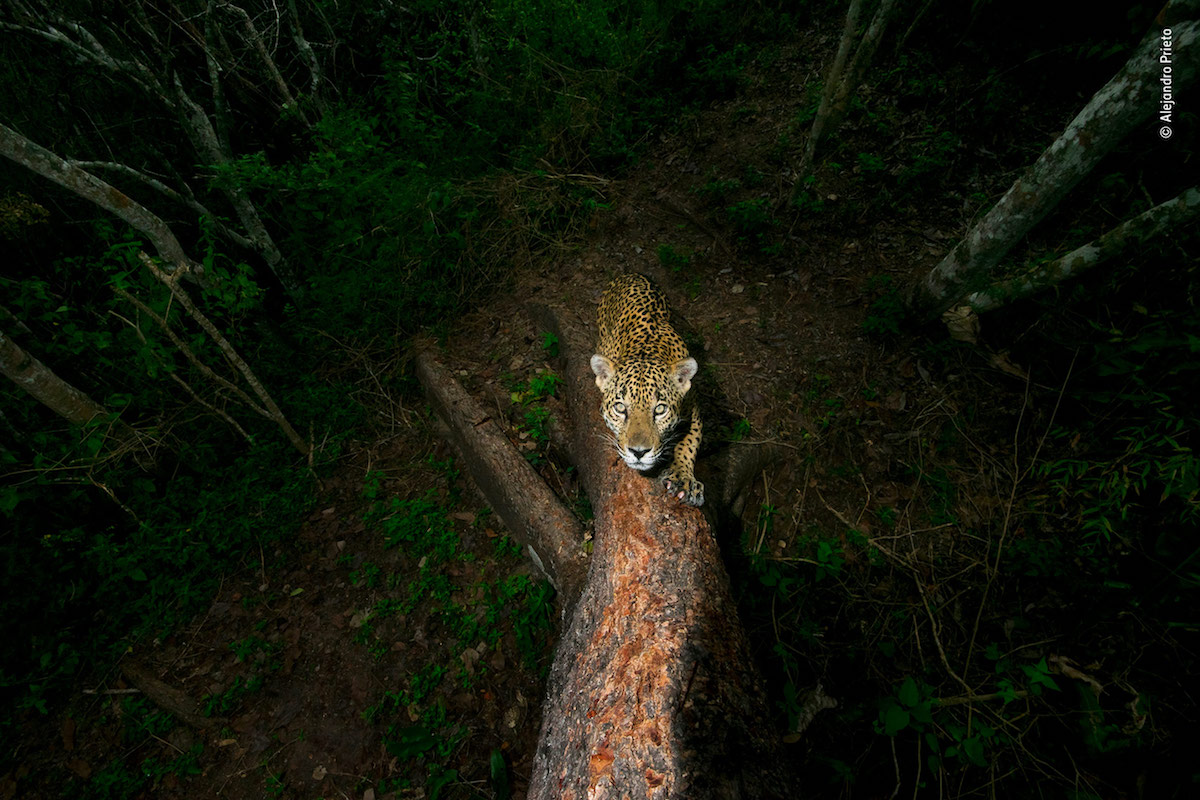
“Signature Tree” by Alejandro Prieto (Mexico). Winner, Wildlife Photojournalist Award: Photo Story.
In the mountain jungle of Sierra de Vallejo, Mexico, a jaguar sharpens its claws by scratching a tree, leaving behind a pungent scent. These marks are a clear warning to others – no trespassing allowed. Male jaguars may roam more than 130 square kilometers and it took this cat eight months to return and refresh its marks.
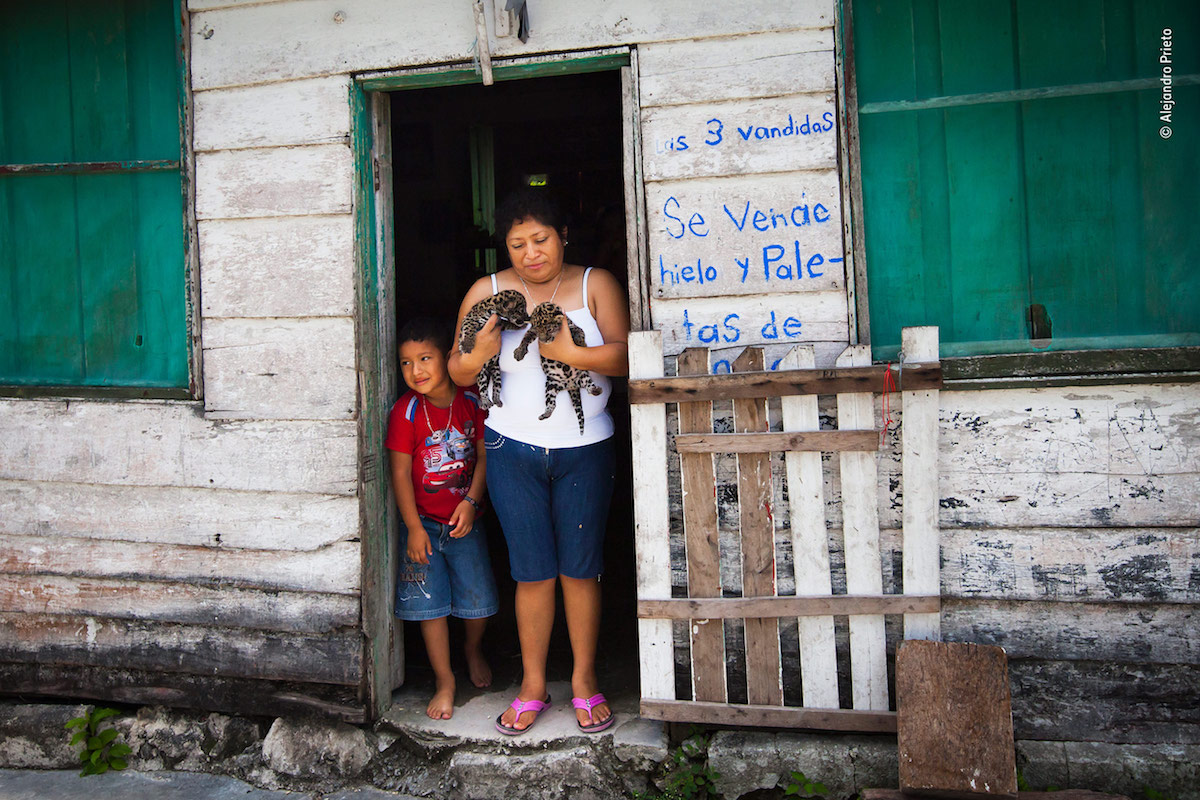
“Hope for the Future” by Alejandro Prieto (Mexico). Winner, Wildlife Photojournalist Award: Photo Story.
This pair of month-old jaguar cubs probably ended up in the village after a hunter killed their mother and sold them as pets. In the wild, these young animals would have stayed with their mother until they were about two years old. Instead, they have been handed in to a refuge. With luck, they will both be returned to the wild after their rehabilitation.
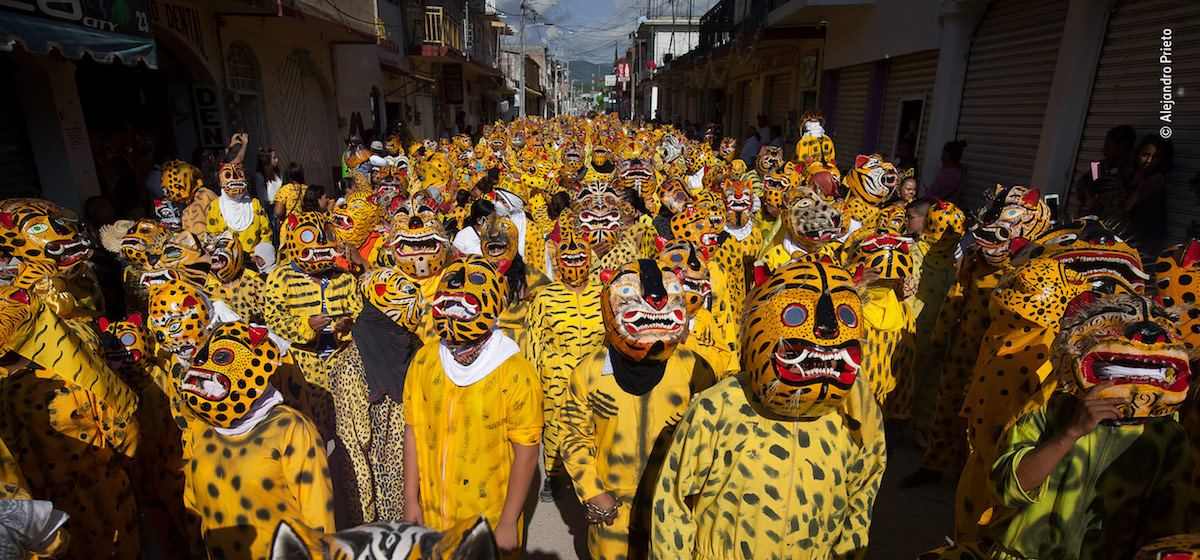
“Jaguars Come to Town” by Alejandro Prieto (Mexico). Winner, Wildlife Photojournalist Award: Photo Story.
Every August in Chilapa de Alvarez, Guerrero, thousands of people congregate together to worship the jaguar, which plays a large role in Mexican culture and mythology. However, in this part of the country, the once common jaguar is now extinct. It’s likely only a few of the older festival-goers remember seeing the occasional paw print in the forest.
Acclaimed wildlife photographer Frans Lanting won the inaugural Lifetime Achievement Award.
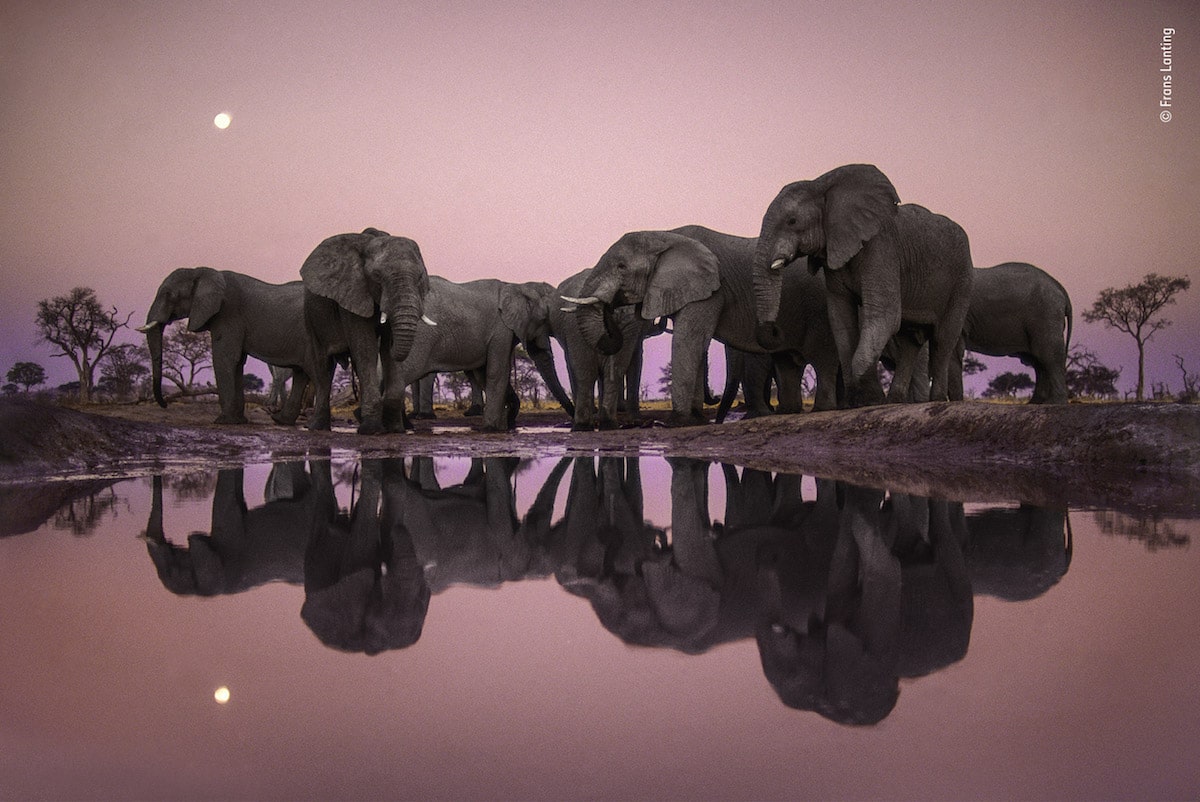
“Elephants at Twilight” by Frans Lanting (The Netherlands). Winner, Wildlife Photographer of the Year Lifetime Achievement Award.
One evening during Botswana’s dry season, I waded into a water hole to capture a shimmering reflection of a gathering of elephants at twilight, with a full moon suspended in a luminous pink sky. The image is my homage to the primeval qualities of southern Africa’s wilderness, the grandeur of elephants, and the precious nature of water in a land of thirst.











































































